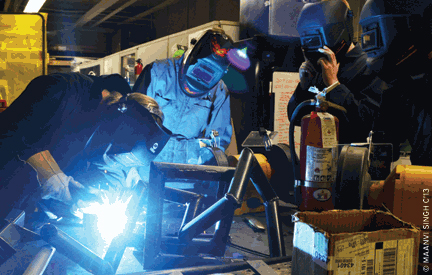
How to build an electric car:
First, find: wheels, chassis, body, lithium-ion batteries, sensors, microcontroller, battery-management system. Oh, and free time. A lot of free time.
Then: Figure it out.
At least, that’s how the Penn Electric Racing Team does it. Their philosophy holds that anyone can build an electric vehicle from scratch, as long as they’re willing to work at it.
Last summer, after four years of effort, the team completed Renegade, a fully custom-built electric drag racer. This year they’ve scaled down a bit. They’re converting a Honda Ruckus scooter into an electric version.
It’s a Wednesday evening, about a year into the project, and the scooter lies—disassembled—on a cement floor in the depths of the Towne building, where Penn Electric has a basement workroom. Senior Will Price and sophomore Andrew Botelho are standing over the parts to discuss how they’re going to put them all back together.
“The BMS is not in series with the sensors, right?” Price asks, referring to their battery-management system.
Bothelo laughs. “Let me look this up.”
Will scratches his head. “Have you checked the data sheet?”
Both students consult their laptops. “Throttle influences, motor current …” Price mutters, trailing off.
There’s a lot to be done. Botelho has to manage the flow of electricity through the vehicle, from battery to motor. He’s programming a microcontroller (basically, a really tiny computer) to serve as the brain that will manage the entire system. The thing is, he’s never had to program a microcontroller before. He’s taking his first programming course this semester.
“I’ve had a pretty steep learning curve,” Botelho says. But thanks to Penn Electric, he tends to know about a lot of things before they come up in his classes. A lot of what he does for the team isn’t even covered in his electrical-engineering coursework.
“The classes are very theory-based,” explains sophomore Oliver Pacchiana, a mechanical-engineering major who’s in charge of building the battery pack for the scooter. At Penn Electric, he’s able to put theory into practice.
Honda’s Ruckus runs on unleaded gasoline. Penn Electric’s Ruckus will run on 400 lithium-ion battery cells donated to the team by Tesla Motors (whose chairman, product architect, and CEO is Elon Musk W’95 [“The Next, Next Thing, “Nov|Dec 2008]). These are the same sort of batteries that power laptop computers, as well as most hybrid and electric vehicles. Pacchiana’s job is to make sure the batteries are securely contained and that they don’t overheat.
“The biggest thing that concerns us about safety are the batteries,” Botelho explains. Specifically, they want to avoid “a big boom.”
To that end, Pacchiana machined all the heat sinks—aluminum cases that wick heat away from the batteries—himself. Precision was crucial. The maximum allowed margin of error was .001 inches. This made for another steep learning curve.
“I was machining for eight hours a day, and at the end of the week I had zero heat sinks completed,” Pacchiana laughs. “Once I got the hang of it, it was easy.” He also designed and hand-bent a series of aluminum cooling tubes.
To ensure that everything they build is safe and efficient, Pacchiana explains, the team has to do a lot of testing and analysis. “What happens when you go over a really big pothole? What happens if it crashes?”
Testing the equipment can be as difficult as building it in the first place. “We write [computer-programming] scripts to model just the dynamics of the car,” says sophomore Tadenda Mushonga, who is designing the scooter’s structural elements. This way, the team is able to simulate how much power the scooter will need when going uphill versus downhill. But the team is still trying to figure out how to test other elements. For example, “We don’t have a set-up to test the batteries extensively,” Bothelo says. If their charge dips too low, “the batteries could be permanently damaged.” If they overheat, well, hello “big boom.”
While avoiding explosions is a given, the Penn Electric team hopes to go a few steps beyond that. They want their scooter to be not only functional and safe but also aerodynamically optimized, energy efficient, and aesthetically pleasing.
To optimize energy use, they’re designing a regenerative braking system—a mechanism that converts the scooter’s kinetic energy during braking into electrical energy that can be stored for later use, as in Toyota’s Prius. In this way, the team is tackling the same problems that commercial electric-car companies face. Price cites his work with Penn Electric as a big reason he was able to intern for Tesla Motors last summer.
When Jedtsada Laucharoen EAS’11 GEng’11 graduated, he says, Penn Electric “had a large influence on the direction I was looking to go in.” He now works for Momentum Dynamics, a company that’s developing technology to allow electric vehicles to wirelessly recharge.
When the Penn Electric team was founded in 1989, it focused on solar-powered cars. But solar cells were extremely expensive. And by 2006, according to Price, it had become clear that battery-powered electric vehicles were playing a more important role in the automotive sector. So the team decided to switch gears.
“I see [electric cars] eventually potentially replacing gas cars,” Botelho says.
Not every member of Penn Electric aspires to work in the automotive industry. Mushonga, for example, is more interested in robotics. And Pacchiana sees the electric-car industry as just one of many places he could end up after he finishes school.
But Penn Electric offers a type of experience that’s useful beyond the realm of electric cars. Laucharoen describes it as “a giant exercise in project management.” The team has a faculty advisor—adjunct professor Robert Jeffoat—but for the most part members direct themselves.
They generally subscribe to the perspective that slow and steady wins the race. But sometimes progress is too slow in coming. Three years into their Renegade car project, the team had whittled itself down to just a couple of dedicated members; people were losing interest.
Knowing that they needed to make visible progress or the club would die, Price and Laucharoen finally, in the summer of 2010, got Renegade running … sort of. They managed to drive it a few blocks over to Hill Field, where a big part of the suspension broke. After working 40 hours a week for the rest of that summer, they managed to really get it driving by September.
Incoming freshmen were impressed.
“We had this influx of like 40 members,” says Price, who notes that the team chose to work on a scooter rather than a full-blown car this year so that new members could start small, and see the results of their work more quickly.
Plans for a future project are still in the works. The team is thinking of building an electric car that can travel long distances on a single charge. Price got the idea during his internship at Tesla, where Tesla chief technical officer J.B. Straubel had been working on a similar project. Straubel is even willing to give Penn Electric some of the equipment that would be required.
“What’s holding us up,” Price says, “is the door downstairs is too small to fit a regular-sized chassis.” Space in the engineering school is limited, so moving isn’t an option. And they can’t widen the door, because their workroom is located in a historic building.
But not to worry. They’re figuring it out.
—Maanvi Singh C’13




